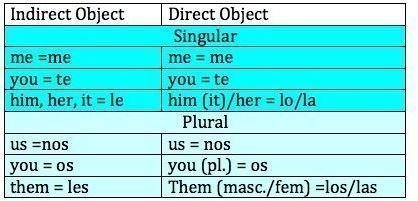Learning How to Use Spanish Object Pronouns
The English Version
Spanish object pronouns have their English counterparts. Like English, they come in two flavors: direct and indirect. An indirect object
tells to or for whom the action of the verb is directed. A direct object receives the action “directly” from the verb. Examples in English:
Bill paid him money. (Indirect object.)
Note that in the case of the indirect object we could also say, “Bill paid the money to him."
Bill sees him. (Direct object)
Now Let’s Try It in Spanish
Using the examples above we would have:
Bill le pagó dinero. (indirect object)
Bill lo ve. (direct object)
Yes, the direct and indirect objects are placed before the verb. This gave me fits when I was first learning Spanish! When we’re dealing with objective pronouns, we not only have to learn the form of the pronoun, but also how to place the objective pronoun relative to the verb. We’ll have more on placement later.
Line-Up of Objective Pronouns

There is some easy memorization needed to keep the direct and indirect object pronouns straight. The easy part is that indirect and direct objects are identical in the first and second persons, (I/we/you) singular and plural. In the third person (he/she/it/they) the indirect objects are le and les; the direct objects are lo/la and los/las. Note the chart below:
Learning to “Think in Reverse”
In the example, “Bill lo ve,” we see that lo (him) precedes ve (see). So the Spanish learner has to get used to a sort of “reverse syntax.” But with practice it becomes more natural as we begin to consider the objective pronoun as part of the “verb unit.” Not so fast, though–there is more to learn. Sometimes the object pronouns follow the verb form. It all depends on how the verb is conjugated in the sentence.
Here is a list of object pronoun placement rules that apply to both indirect and direct objects:
1. Place object pronouns before the conjugated (non-infinitive) form of the verb:
Pablo nos llamó por teléfono. (Pablo called us on the telephone.) (Indirect object)
Siempre las veo en la iglesia. (I always see them [fem.] in Church.) (Direct object)
2. If the verb is in the infinitive, you can either attach the object pronoun to the end of the infinitive or place it before the conjugated verb that accompanies the infinitive. It sounds more complicated than it is. Note the following examples:
Debes prestarle el dinero. (or Le debes prestar el dinero.) (We should lend him the money.) (Indirect object)
Voy a hacerlo mañana. (or Lo voy a hacer mañana.) (I am going to do it tomorrow.) (Direct object)
3. If the verb is progressive (the -ing or gerund), the same rules as for the infinitive apply:
Está dándoles el dinero. (or Les está dándo el dinero.) (He is giving them the money) (Indirect object)
Está buscándolas por el parque. (Las está buscando por el parque.) (He is looking for them [fem.] in the park.) (Direct object)
Note the placement of the accent mark on the progressive form. It maintains the verb syllable stress.
Using Indirect & Direct Objects in the Same Sentence
We sometimes double-up our objective pronouns in English. For example, “I gave him it.” In Spanish we can double up our direct and indirect objects in a sentence, but we have to remember one easy and another not-so-easy rule:
1. The easy rule: Always keep the direct object “directly” in front of the verb. The indirect object precedes the direct object. Thus: Me lo dijo. (He told me it.)
2. The not-so-easy rule: The indirect objects le and les change to se when they are used with the direct objects lo, los, la, or las. (In other words, no “double L’s” allowed.) Thus: Se lo dio. (He gave him it.)
Additional Resources
Bright Hub Education on Spanish Pronouns.
